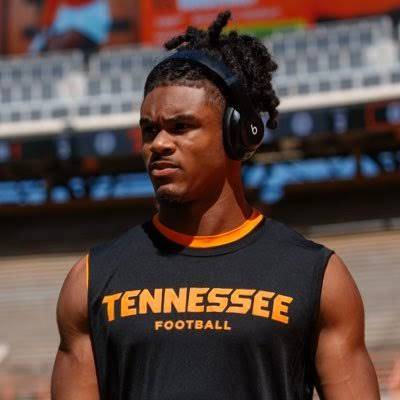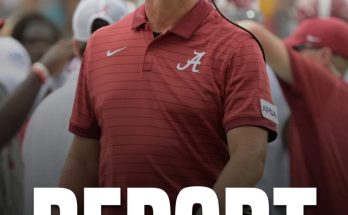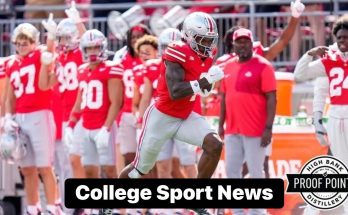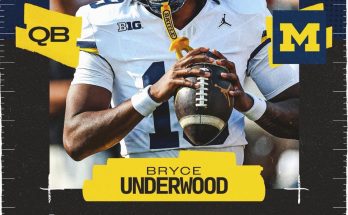The Tennessee Vols opened SEC Media Days with a clear focus on progress—on healing, on preparation, and above all, on their return to dominance. Central to that narrative, particularly on the defensive side of the ball, is cornerback Jermod McCoy, fresh off a breakout season and fresh off the operating table. Head coach Josh Heupel, in Atlanta, offered the most detailed public comments yet on McCoy’s recovery from the ACL tear he sustained during offseason workouts in Texas. The timing couldn’t be more crucial. Tennessee’s opening game against Syracuse looms in less than two months, and fans are understandably eager: when will the lockdown corner be back?
Heupel began cautiously, underscoring the uncertainty that surrounds any ACL rehabilitation. When pressed for a firm timeline, he simply responded, “I don’t (have a timetable)” Wikipedia+9Saturday Down South+9On3+9On3+1On3+1. That phrasing echoed across multiple outlets. On3’s Grant Ramey captured it directly: “he didn’t have an updated timeline” On3+1On3+1. From Heupel’s viewpoint, the path to returning isn’t dictated by a calendar—it’s dictated by McCoy’s progression through each rehab stage. The coach emphasized that the next phase of his recovery is unfolding “throughout the course of the end of summer and training camp,” and that the staff will have a clearer sense of his availability as the season approaches On3+3Rocky Top Insider+3Saturday Down South+3.
He also stressed that while McCoy is undeniably “a huge part” of Tennessee’s defense—“defensively” is how he described the magnitude of McCoy’s role—long-term health is as essential as short-term impact On3+5On3+5All for Tennessee+5. Any inclination to rush him back prematurely would risk undermining a player regarded as one of the top cornerbacks in college football and a likely first-round pick in the 2026 NFL Draft On3.
That careful stance isn’t just coach speak; it reflects real concerns about long-term performance and durability. ACL injuries require meticulous management, and You can’t just overlay optimism for early returns onto actual biology and biomechanics. Tennessee isn’t taking shortcuts. Fall camp is fast approaching, but Heupel’s tone remained deliberate. “We want him,” he said, “but we’re keeping in mind his short-term and long-term health” All for Tennessee+4All for Tennessee+4Rocky Top Insider+4. That added qualifier—“long-term health as well”—reveals a measured commitment: this isn’t a question of will or desire; it’s one of physical readiness.
That readiness isn’t abstract. Heupel noted that he’s recently seen McCoy in rehab and observed “he looks really good… his movement skills are good” All for Tennessee+7Rocky Top Insider+7Saturday Down South+7. That marks real progress. Rehab centers around regaining mobility, reconstructing muscle memory, and reestablishing confidence—not just in moving, but in cutting, planting, shifting weight, and reacting. For a cornerback whose game is built on abrupt bursts and precision, those markers are essential. The coach’s reference to a multi-stage progression—”next phase and next stage”—hints at targeted milestones: agility, strength, and football-specific drills.
Still, no timetable means no guarantees. The projected return window remains open. By the end of summer, it may be clear whether McCoy can safely return for the August 30 opener against Syracuse at Mercedes‑Benz Stadium in Atlanta. If not, broader season-readiness could be the realistic target, even if that means missing early games On3+1All for Tennessee+1.
That prospect is sobering. Analysts from FanSided have speculated that McCoy is unlikely to be part of the Week 1 lineup—and possibly out for longer . The real question becomes: when will he return, and will it be in time for Tennessee’s marquee early-season matchups? The Vols face Syracuse on August 30, then host ETSU a week later and line up for a huge SEC clash at home against Georgia on September 13 . Staying on the sideline for the first two would be manageable, especially if Tennessee prioritizes his conditioning and recovery. But any further delay risks blunting their defensive potential in crunch time.
For context, McCoy’s value is more than theoretical. As a transfer from Oregon State, he already posted 31 tackles and two interceptions in 2023. Last year, recognizing his rare athleticism and ball skills, Tennessee trusted him as a full-time starter. He delivered: 44 tackles, nine passes defended, and four interceptions, earning first-team All-SEC honors and national acclaim On3. Pro Football Focus tabbed him as the second-best returning Power Four corner in coverage and pointed to his 89.6 PFF coverage grade On3. On3 placed him 17th in its preseason player rankings; PFF named him 13th On3+2On3+2Saturday Down South+2. Unreal for a sophomore—yet here he is, sidelined and respected.
That kind of production shapes how Tennessee imagined this season’s defense. The Vols ranked second in the SEC and seventh nationally in scoring defense last season, a major reason they secured a College Football Playoff berth Saturday Down South+2On3+2Rocky Top Insider+2. McCoy’s presence would be the glue holding that defense together. Without him, there’s an obvious hole across from Rickey Gibson III—unless Ashland transfer Colton Hood from Colorado, also a corner/nickel hybrid, can pick up the slack during camp On3+1Rocky Top Insider+1.
Still, hope remains realistic. Doctors and trainers now expect athletes to return to play later in the same season after ACL tears if rehab goes well. Some college corners return in nine to ten months; McCoy is within that range—his injury occurred in January, so an October or November return is feasible, if not ideal. Fans on Vol Nation’s forums are quick to chime in. One optimist even speculated, “Kid is a thoroughbred. He won’t start the first game but he’ll play this season” volnation.com. Another noted the advances in medical science, predicting he’d be ready by October’s Arkansas game . That aligns with Heupel’s stage‑by‑stage description.
It’s possible Tennessee plans a soft reintroduction—a few snaps in non-conference play or limited early-season duties to ease him back. The defensive scheme allows for rotation and situational packages. That could be the worst-case/perfect-world middle ground: get McCoy back by mid‑to‑late September, build timing, and unleash him later in SEC season.
Tennessee already fields a deep room of defensive backs. If early camp reveals that McCoy is still behind in strength or reactive quickness, coordinator Tim Banks will lean on experience and depth to close seams and disguise coverage. But losing the audited ball skills of McCoy—particularly his knack for reading quarterbacks and baiting throws—would be significant. His four interceptions and nine pass breakups weren’t flash—they were foundation for the Vols’ confidence.
Heupel made it clear this week: the coaching staff understands that loss. He underlined not just the desire to have McCoy, but the wisdom in ensuring he returns fully built—not rebuilt prematurely. In Heupel’s own words, “We’ll figure that out as we get into the season” volnation.com+8Rocky Top Insider+8On3+8.
That honest uncertainty is rare for a coach at high-profile media events. It speaks to several realities: respect for the severity of McCoy’s injury, acknowledgment of how vital he is, and willingness to adjust strategy. After all, Tennessee’s season won’t hinge on one player; they’ve prepped contingency plans. But one elite cornerback can make a chain reaction—quarterbacks avoid throwing his way, fewer explosive plays happen on his side, safeties can roam more confidently.
What’s on the horizon? In two weeks, fall camp begins. That’s when rehab will move from controlled environments to full-speed reps. Heupel and Banks will monitor progress, coordinate practice reps, and more importantly, interpret how McCoy holds up under contact and fatigue. By late August, they’ll have a projected timeline—whether Week 1, Week 2, Week 3, or later in September. Whether Syracuse will see him in coverage will be clearer.
One thing remains certain: Tennessee values McCoy not just as a standout defender now, but as a cornerstone for the NFL Draft next spring. He’s projected as a first-round pick in 2026; The Athletic places him at No. 11, USA Today at No. 12, Todd McShay No. 13, and CBS Sports No. 20. ESPN’s Matt Miller selected him 15th, conditioning it on recovery On3. He’s draft capital—and college treasure.
That dual value adds gravity to every step. An early return is sweet if he can tango through a full season. But rushing is a gamble. Heupel’s message channels patience, caution, and ultimate control. He’s saying: we own this rehab; we’ll set the pace.
That attitude cracks open a deeper understanding of how elite programs manage injuries today. It’s not hero culture. It’s high-performance culture—with protocols, science, individualized rehab plans, stepwise testing, and return-to-play gates. It doesn’t just protect the player; it protects the institution and the fan base, too. Tennessee is signaling readiness to bend the timeline if needed.
For Vol fans, that means hope tempered with realism. Heupel’s posture hasn’t shifted toward defiance or prediction. It’s waiting with confidence. When McCoy will return comes down to when he’s ready—not when we want him to be. And given what he brought last season, readiness matters as much as talent.
As SEC Media Days recede into memory and camp approaches, all eyes will track progress. How swiftly can McCoy cross back into coverage drills? How many reps can he handle before fatigue sets in? How fiercely is he able to redirect and close on routes? When pads come on, will he dip and drive without hesitation? Each drill—and each interview—brings a pulse check.
Heupel’s closing message, off the podium, was simple and instructive: “We want him. We’re going to monitor it. We’ll make the decision when it’s right for him and right for the team” . That clarity—no timeline, no false hope, no speculation—may ultimately pay dividends. It demonstrates unity across coaching, training staff, and McCoy himself.
If that trust yields a late-season return to dominant play, so much the better. If it means he operates at 90% early on, but at 100% midseason, Tennessee will be fine—because they balanced passion with prudence. When McCoy retakes the field, fans won’t just cheer for a player—they’ll celebrate a process, a program, and a promise kept.
The keys are in place. Fall camp begins soon. Media will ask again. McCoy’s rehab is turning phases. Progress is gradual but visible. Tennessee’s coaching staff knows how significant his return will be, and they’re playing the long game.
When the season opener arrives, the Vols will know if he’s ready to lock down D1 wideouts. If not, by October, they expect to be fully reinforced—and McCoy ready to shine again. If his journey mirrors that of modern ACL recoveries, it’ll be a powerful case study in patience, planning, and performance. And whatever the result, everyone watching this summer will see one thing: Tennessee’s dedication to its players isn’t just in playbooks—it’s in protocol.



